Last Updated on March 31, 2024 by foxintheforest
The Grand Canyon is magnificent any time of year. However, the Grand Canyon in March offers a unique opportunity to see the canyon in all sorts of different conditions. With wildly unpredictable weather, you may encounter a snow-dusted canyon or you could find yourself in a t-shirt!
I’ve visited the Grand Canyon many times. My area of expertise lies beyond the basic tourist track and dives deep into the little-known areas of the Big Ditch. So if you’re looking to experience the Grand Canyon like a pro, not a tourist, then you’re in the right place.
About this Guide to the Grand Canyon in March
Inside this expert guide to the Grand Canyon in March you’ll find:
- Insider info about the weather in March
- Details about spring break at the Grand Canyon
- What to do and see in the Grand Canyon during March
- Where to stay
- Additional planning resources
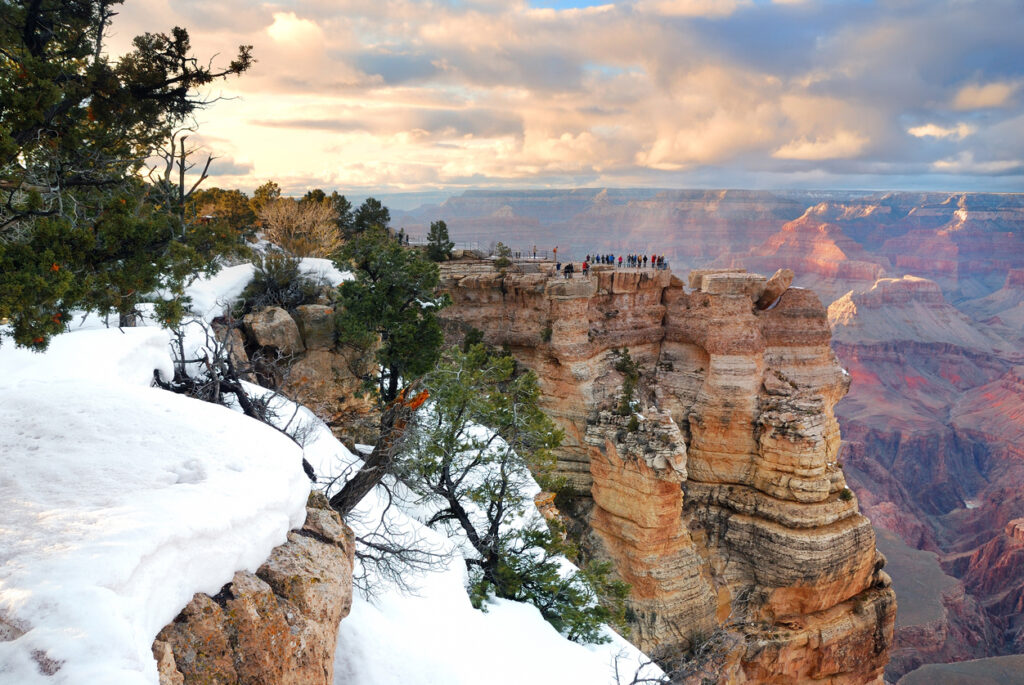
March Weather in the Grand Canyon
March is a wild time in and around the Grand Canyon. Although March usually marks a great time to visit the American Southwest, the South Rim of the Grand Canyon sits at roughly 7,000 feet above sea level. This means that the weather is unpredictable and variable.
Here’s a look at typical temperatures:
- South Rim (only rim that is open): the average high is 51 F and the low is 21 F
- Inner canyon temperatures in March: The average high is 71 F and the low is 48 F
- North Rim (not open in March) Average high is 44 F and the average low is 21 F
Does it snow in March at the Grand Canyon?
Snow is certainly a possibility at the Grand Canyon in March. In fact, anything goes. Early in March has a higher chance of snow than late March. The inner canyon will likely not see snow (it’ll fall as rain). To put this in perspective, the South Rim sees around 58 inches of snow per year, while Phantom Ranch, at the bottom of the Grand Canyon, sees just 1 inch.
Is March a Good Time to Visit the Grand Canyon?
Yes and no, honestly. Spring and fall are the best seasons (with October being the best month to visit the Grand Canyon). Early March is great if you don’t want to see a lot of crowds, but if you’re planning big hikes or backpacking you’ll want to bring microspikes for traction and pack for all sorts of weather.
Later in March, spring break crowds can overwhelm the Grand Canyon, which can detract from the experience. However, as an expert in avoiding the crowds, I’ll give you plenty of tips here in a minute!
March tends to be windier, wetter, and more unpredictable than say April or October. That can work for you or against you. If you want the chance of snow, but would prefer warmer temps, March is a great time. If you’re looking for warm weather or you’re traveling to the inner canyon, early April is a better bet.
Pro Tip: I’ve backpacked in the Grand Canyon with a snowstorm. It was certainly an adventure and not one I’d be too keen to repeat.
Positives of visiting in March
- If the weather cooperates, it’s pretty mild and can be pleasant for hiking
- If you want to see snow, but don’t want a guarantee, early March can be a great option (just be prepared and pack appropriate gear)
- Early march sees fewer crowds
- Inner canyon temps are warm and pleasant instead of being like a blast furnace
Downsides of Visiting in March
- The unpredictable weather might not work in your favor. Roads can (and do) close.
- Dirt road travel is dangerous if the weather is not clear.
- Trails can still be icy, even if the weather is mild
- late March and spring break are quite busy
- The North Rim is closed
Pro Tip: If you’re unsure about what to do and where to go at this time of year, you can always check out a Grand Canyon tour from Pheonix.
Is the Grand Canyon Crowded in March?
Early March is still the low season for the Grand Canyon, which can be great for a quiet getaway. However, around spring break time (usually two weeks), the Grand Canyon becomes very crowded.
Pro Tip: If you want to beat the crowds, plan on being in the park before sunrise. Do the busiest activity on your itinerary first, then you’ll be one step ahead of the crowds for the day.
Grand Canyon for Spring Break
So I’ve got a child and I get it – you only have limited time to travel with school. The Grand Canyon is a great spring break trip, just don’t expect a quiet park.
You can find solitude IF you get started early (like sunrise early). For big viewpoints such as Mather Point, and Yavapai Point, aim for a sunrise visit.
The other way to beat the crowds is to stay away from hikes along the rim-to-rim corridor, and instead tackle other inner canyon hikes.
Grand Canyon with a Baby
My daughter’s first trip to the Grand Canyon was when she was just 4 months old (we went to the North Rim). She’s a real adventurer (she doesn’t have much of a choice – since this blog is my job) and she did great!
Toddlers and young kids may struggle here if they aren’t able to listen and (understandably) nervous parents worry about the precarious drops. I recommend a kid carrier, such as a backpack, for younger toddlers while explaining to younger kids that the cliff edge is dangerous.
Many of the overlooks have railings, but some of the best views of the Grand Canyon don’t have protection on the drop-offs! Just be sure to pay attention and plan accordingly!
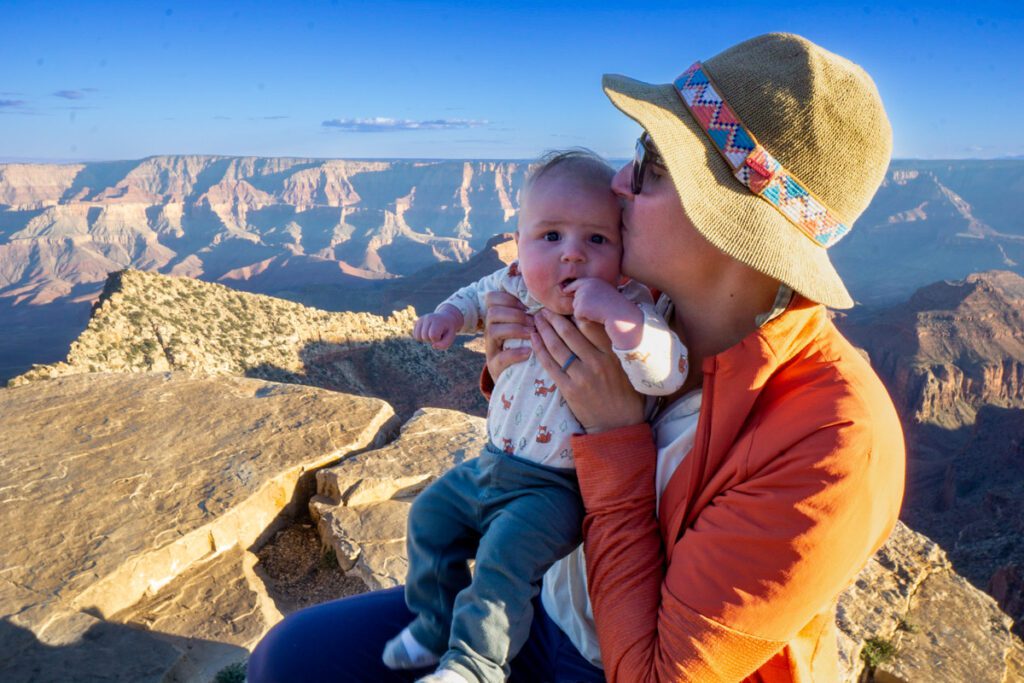
What Parts of the Grand Canyon are Open in March?
If you’re debating between the north rim vs the south rim of the Grand Canyon in March, I’ve got news. The South Rim is the only part of the Grand Canyon National Park that is open in March.
You can access the North Rim, but you’ll need to do so on foot (usually requiring many, many miles of snow travel). However, you’ll need a permit and you’ll need to be self-sufficient. I would only recommend this if you’ve had plenty of experience with winter camping and in the Grand Canyon.
Pro Tip: If you really want to see the North Rim of the Grand Canyon in March, consider snagging a permit to the remote Toroweap Overlook and spend the night at the Tuweap Campground. It’s lower in elevation and a very secluded experience.
Top Things to Do in March
Countless Grand Canyon activities will keep you coming back again and again. Here are a few of my favorites for March!
Go for a Hike
There are plenty of incredible Grand Canyon hikes to explore. I’m a huge fan of getting beyond the South Rim Village and rim-to-rim corridor, but the hikes do get more challenging away from the nicely maintained “highway” trails of the corridor.
So if you’re up for an adventure (and you are reasonably fit) I would recommend the following off-corridor trails:
- Grandview Point to Horseshoe Mesa
- Hermits Rest to Santa Maria Spring
- Dripping Spring
Rim hikes tend to be more crowded, but they are a nice way to enjoy a hike without the intensity of going below the rim. Here’s a look at a few must-do trails
- Rim trail
- Hermits Rest rim trail
- South Kaibab to Shoshone Point
The rim-to-rim corridor offers the “easiest” (none of these are easy) way to dip below the rim. A few favorites that are perfect for March include:
- South Kaibab to Ooh Ahh Point
- Bright Angel to either 1.5 miles or 3-mile rest house
- South Kaibab to Skeleton Point
Pro Tip: In 2024, the Bright Angel Trail is completely closed until April 15th.
Pro Tip: Heading on a hike in the corridor? Start at sunrise to beat the hordes of people who head down here – even on a quiet day both Bright Angel and South Kaibab are quite busy!
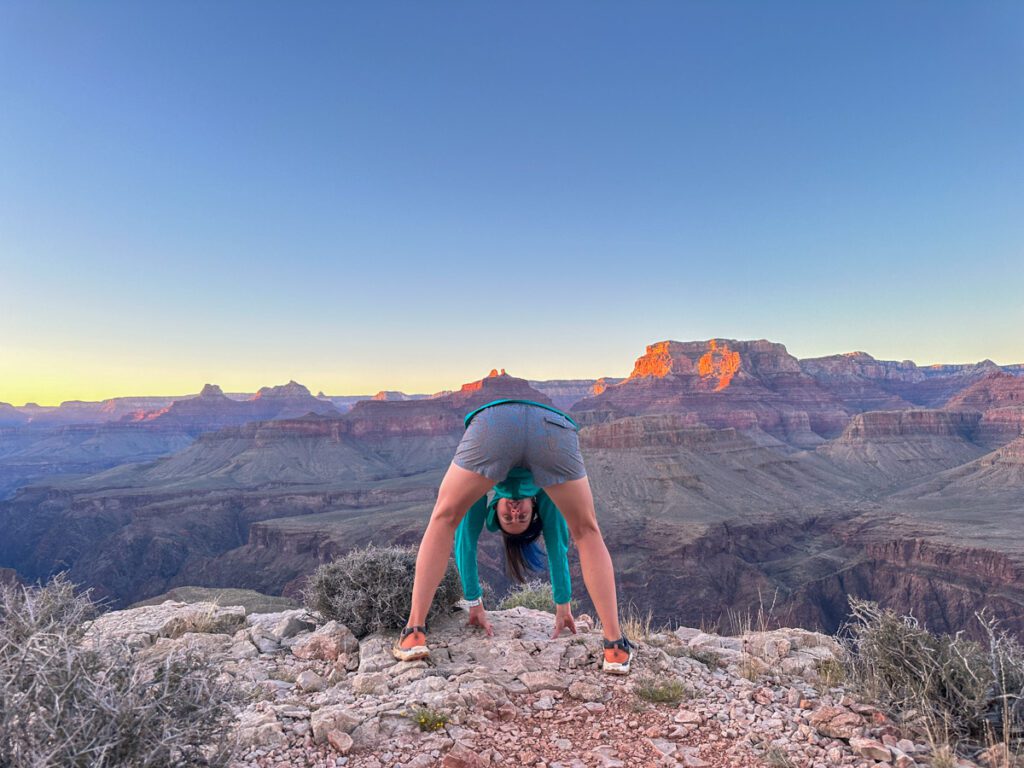
Can you hike the rim-to-rim in March?
Avid trail runners and advanced day hikers can do the rim-to-rim in a day. However, in March there are no services on the North Rim of the Grand Canyon, so you’ll be doing the rim-to-rim-to-rim which is substantially harder. So I’d suggesting doing the rim to rim in early October, when the North Rim is open.
Alternatively, you can backpack the rim-to-rim in March, but again, you’ll be doing the rim-to-rim-to-rim – meaning your journey will be more difficult.
Backpacking the Grand Canyon in March
March is a popular time to backpack in the Grand Canyon. This is largely because the daytime highs in the inner canyon aren’t too intense. However, the tradeoff is there is the potential for bad weather. Bad weather also brings easy access to water if you’re backpacking off-corridor routes (which I highly recommend if you’re experienced!).
The biggest downside for backpacking the rim to rim in March is that you’ll have to come in and out of the South Rim, since the North Rim is closed. This means you’ll be doing the rim to rim to rim.
One great way to lessen the load is to camp two nights in the inner canyon. You can day hike to the North Rim and back in a day, without carrying your pack weight. Then you can continue back to the south rim.
Pro Tip: The water stations along the Corridor do shut off intermittently throughout the winter, so be sure to check on water conditions when planning your hike.
Backpacking Permits
In order to backpack anywhere in the Grand Canyon, you’ll need advanced permits. Permits are now available via a lottery system 5 months in advance. If you’re backpacking in the corridor (ie doing the rim-to-rim) you’ll absolutely want to enter the lottery, since they spots will fill up.
Take a Tour
Don’t like the hassle of planning your own trip? Don’t worry. There are several awesome Grand Canyon tours you can take to get the most of your time here. My suggestion would be to opt for one of the Grand Canyon sunset tours since these expert guides will be able to find all sorts of hidden views for amazing sunset photography or enjoyment.
Catch a Sunrise or Sunset
Photographing the sunrise or sunset in the Grand Canyon is an incredible experience. In general, sunrises are much quieter (and my preferred time to go). During the busy weeks of spring break – catching a sunrise is a great way to get one step ahead of the crowds.
A few of my favorite spots to see the changing of the day include:
- Hopi Point (sunset)
- Mather Point (sunrise)
- Grandview Point (either)
- Moran Point (either)
- Lipan Point (either)
- Yaki Point (sunset)
- Desert View Watchtower (sunset)
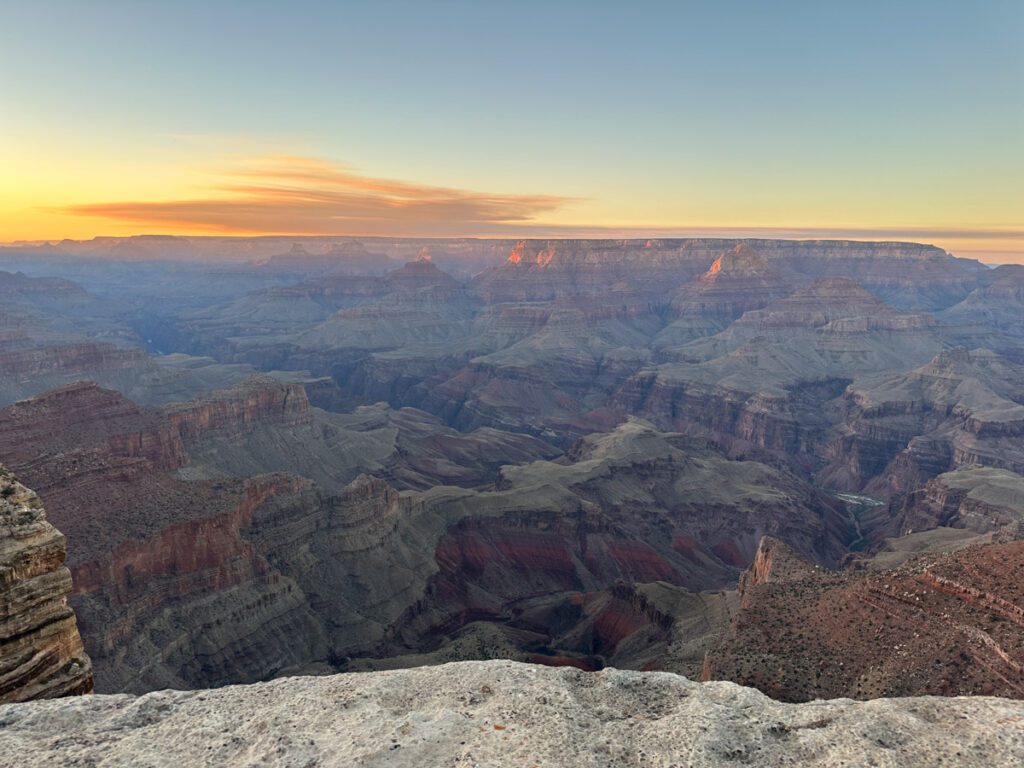
Rafting in March
Technically March is the start of the rafting season in the Grand Canyon. But, I would advise against it. It’s typically very cold for a long river trip. You’re better off waiting until April or May for a river trip.
Take a Mule Ride
Mule rides into the inner canyon are a classic Grand Canyon activity. There are several different options for mule rides and this is an excellent adventure if you want to dive into the canyon, but you’re not a big hiker. Rservations must be made in advance, by phone and it costs around $178 per person for a 2 hour ride. Certainly not cheap, but definitely a classic experience.
One incredible thing to do is to snag a spot at Phantom Ranch and spend the night. This is a highly-competitve activity that requires a lottery entry 15 months in advance. Your chances are slim, but you may get lucky!
Take a Train Ride
For a scenic journey to the Grand Canyon, catch the train in Williams. Ride this old western train directly to the Grand Canyon Village. This is a very touristy activity, so if that’s your thing, then hop aboard! Just remember, you’ll be coming with a large crowd that will likely stick with you throughout the day.
What to See in the Grand Canyon in March
There are tons of things to see in the Grand Canyon. Seriously. I keep coming back and I’ve only done a couple of repeats. So don’t worry if you can’t squeeze it all in!
Desert Watchtower
This is a replica of a past tower from the original tribal inhabitants of this space. Constructed in 1932 by the amazing Mary Colter this magnificent structure commands views in all directions of the Grand Canyon, Sna Francisco Peaks, and Painted Desert.
You can go in the tower and see magnificent artware and murals by Fred Kabotie – a Hopi artist, as well as immerse yourself in the unique history of the Grand Canyon.
Hermits Rest Road
Starting in March you’re no longer able to drive Hermits Rest Road, but you can hike or take the shuttle. There are several amazing viewpoints along the way to Hermits Rest (another Mary Colter building). My suggestion would be to hike out to Hermits Rest and then take the shuttle back. This leisurely hike is a great way to get some sense of quiet along the busy rim of the Grand Canyon.
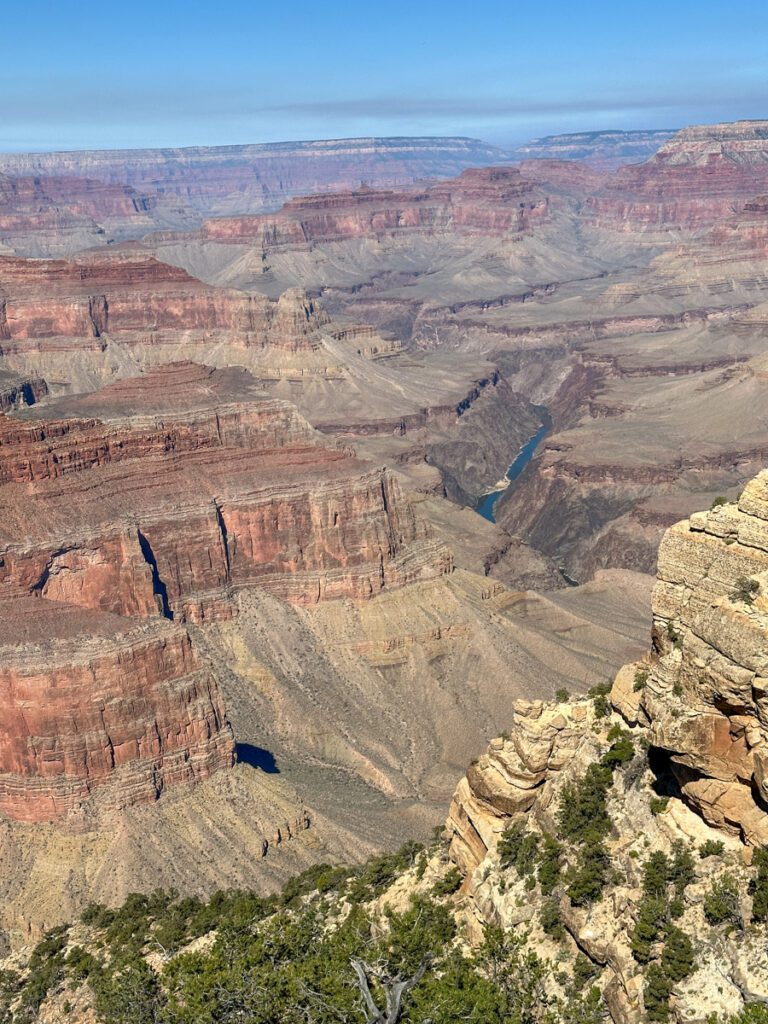
Check Out the Top Viewpoints
There are tons of stunning Grand Canyon viewpoints to check out. In March you can get snow-dusted canyon views which is a real treat!
My absolute favorite viewpoints are:
- Hopi Point
- Horseshoe Mesa Left Arm
- Ohh Ahh Point
- Lipan Point (pictured)
- Grandview Point
- Moran Point
Pro tip: The best time of day to visit viewpoints is during the Golden Hour (the hour or so before sunrise/sunset), sunset/sunrise, or what I call the afterglow. The cliffs glimmer in the fading light of sunset (and just before sunrise) in a way that’s truly magical. That’s how you get the best photos of the Grand Canyon.
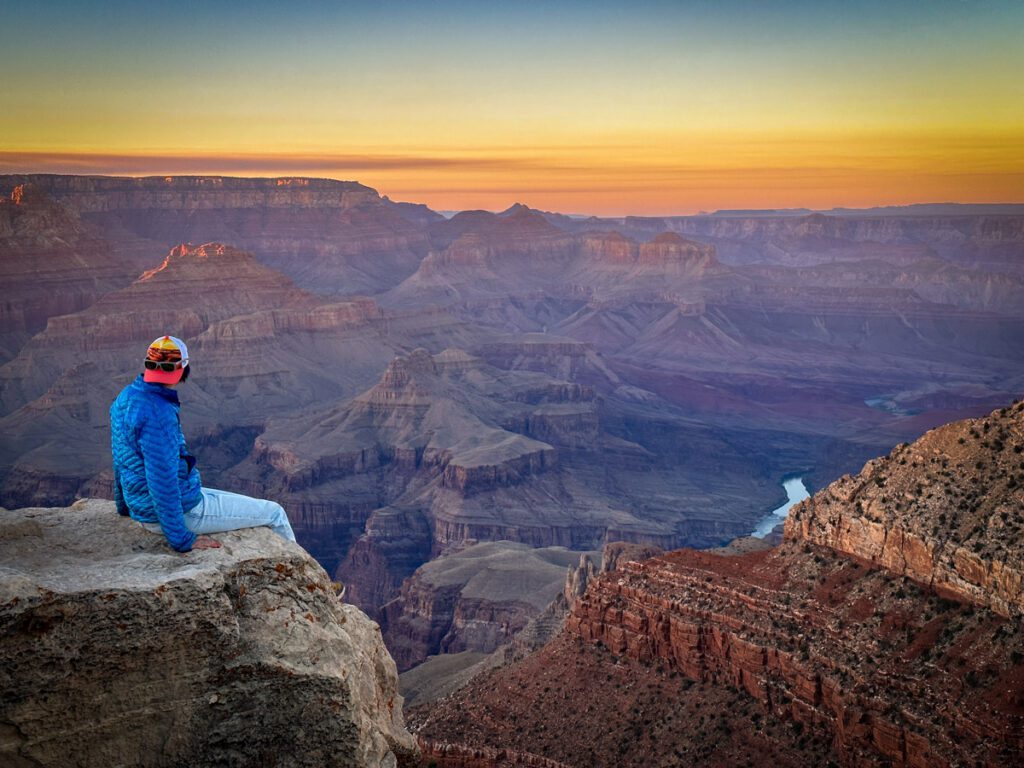
Where to Stay for Your Grand Canyon Visit
There are limited options when staying in or near the Grand Canyon, and I’m not going to lie – all of them are pretty pricey!
The lodging at Grand Canyon Village books up almost immediately, starting a year out. You can often get lucky with cancelations, but you’ll need to check daily!
Tusyan is a decent home base. The food is meh and it’s pretty touristy. But the hotels are just slightly cheaper. However, the convenience can’t be beat!
In the Park
Park lodging is extremely expensive (think $300 a night and up) and in my opinion, a bit over-rated. However, if you’re short on time and you want to pay for the convience, it can’t be beat.
El Tovar Hotel
This historic hotel has been operating since 1905 and it’s a much-coveted spot! Rooms are pretty pricey and most don’t have a view, but given the location, you don’t have to go far to find scenery!
Bright Angel Lodge
Another popular option in the park, Bright Angel Lodge is a stunning Mary Colter building. They have cabins as well.
Other Options
Kachina Lodge, Thunderbird Lodge, and Maswik Lodge are also viable options within the park. All of these spots are managed and run by Xanterra – a huge private company that has contracts with the national park.
Nearby Towns
Tusayan is the nearest town to the south rim, but it’s a very under-whelming tourist town. Whenever I come for quick trips to the Grand Canyon, I stay at the Holiday Inn Express (we liked the adults-only building). It’s easy, convienent, and nothing to write home about. But you won’t be spending much time there anyway! It’s about 7 minutes to the park entrance.
Williams is another popular spot to base yourself. It’s about an hour from the Grand Canyon and much cheaper to stay here. But you’ll have a bit of a drive. I personally haven’t stayed here, so I don’t have any recommendations, but it’s worth looking into if you don’t want to camp and you have a tighter budget.
Camping
Camping is available in the park (Mather Campground or Trailer Village RV Park). However, it will be quite cold at night. I personally wouldn’t recommend it unless you have heat or a winter camping setup.
Pro Tip: Learn how to find free camping right near the Grand Canyon. Usually this is where I stay when I visit the Grand Canyon.
What to Bring
Be prepared for your desert adventure. Even though the temperatures might be cooler, you’ll still want to pack plenty of liquids (deserts are dry afterall!). Here’s a look at what I bring on every trip to the Grand Canyon.
- Plenty of water – I like to use a water container for the car. Budget at least 4 liters per person per day, more if you’re out in the summer months.
- Sunscreen, sunhat with a wide brim, sunglasses
- Sunshirt
- First Aid Kit with tweezer (for cacti)
- Noncotton socks
- Breathable footwear that you feel comfortable wearing all day
- Non-cotton shorts for hiking
- Non-cotton, lightweight pants for hiking. Pants protect you against aggravating foliage.
- Non-cotton, breathable t-shirt for hiking (the sun can really beat you up if you wear tank tops, so be aware)
- Electrolyte powder
- A water bladder capable of carrying at least 2 liters of water.
- Salty snacks
- Camera
- Camera clip to strap to your back
- Beanie – the desert can get cold at night so warm clothes are great to have
- Glove liners
- Fleece layer (fall through spring)
- Puffy layer (fall through spring)
- Hiking poles (optional)
- A hiking pack. I love the REI Flash series for something mutli-use and economical
- A toilet kit: shovel, WAG Bag (most national parks require this), hand sanitizer, TP/baby wipes, a small plastic baggy to pack out TP and sanitary items
- Pee funnel – optional
- Pee rag – optional
- A plastic baggy for trash (wrappers, fruit peels, etc). I like to use compostable dog waste bags.
- Headlamp
- GPS navigation
- emergency communication device
- Wind/rain layer
- Pocket knife
Additional Grand Canyon Planning Resources
Looking to explore the Grand Canyon like a pro, not a tourist? Then check out these handy resources:
- The Absolute Best Backpacking Routes in the Grand Canyon (coming soon)
- Grand Canyon Tours that Leave from Pheonix (coming soon)
- The Ultimate Denver to Grand Canyon Road Trip
